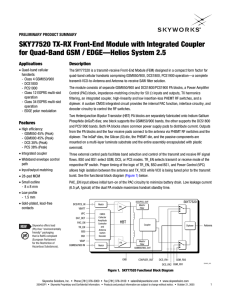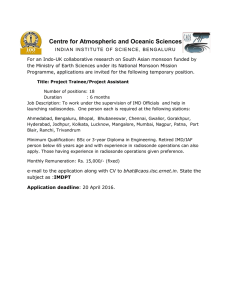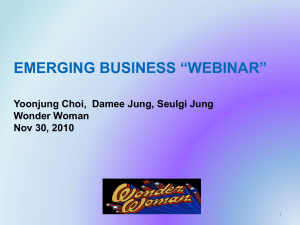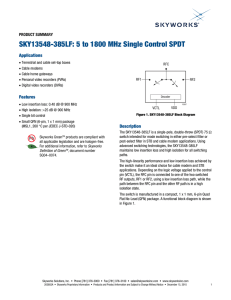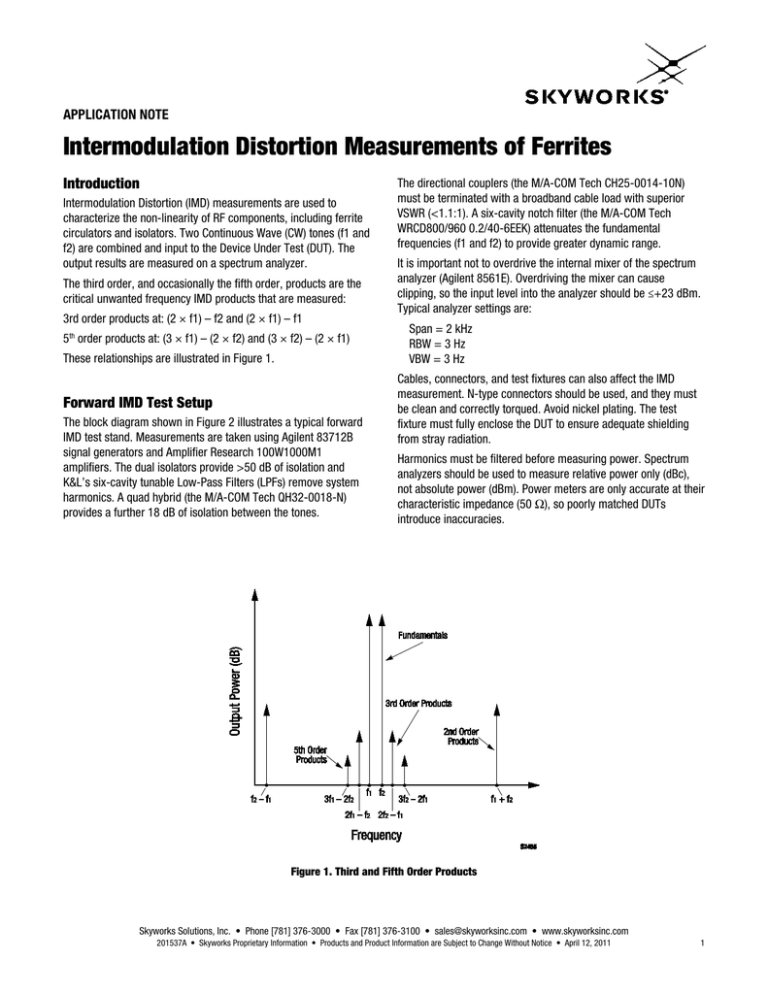
APPLICATION NOTE
Intermodulation Distortion Measurements of Ferrites
Introduction
Intermodulation Distortion (IMD) measurements are used to
characterize the non-linearity of RF components, including ferrite
circulators and isolators. Two Continuous Wave (CW) tones (f1 and
f2) are combined and input to the Device Under Test (DUT). The
output results are measured on a spectrum analyzer.
The third order, and occasionally the fifth order, products are the
critical unwanted frequency IMD products that are measured:
3rd order products at: (2 × f1) – f2 and (2 × f1) – f1
5th order products at: (3 × f1) – (2 × f2) and (3 × f2) – (2 × f1)
These relationships are illustrated in Figure 1.
Forward IMD Test Setup
The block diagram shown in Figure 2 illustrates a typical forward
IMD test stand. Measurements are taken using Agilent 83712B
signal generators and Amplifier Research 100W1000M1
amplifiers. The dual isolators provide >50 dB of isolation and
K&L’s six-cavity tunable Low-Pass Filters (LPFs) remove system
harmonics. A quad hybrid (the M/A-COM Tech QH32-0018-N)
provides a further 18 dB of isolation between the tones.
The directional couplers (the M/A-COM Tech CH25-0014-10N)
must be terminated with a broadband cable load with superior
VSWR (<1.1:1). A six-cavity notch filter (the M/A-COM Tech
WRCD800/960 0.2/40-6EEK) attenuates the fundamental
frequencies (f1 and f2) to provide greater dynamic range.
It is important not to overdrive the internal mixer of the spectrum
analyzer (Agilent 8561E). Overdriving the mixer can cause
clipping, so the input level into the analyzer should be ≤+23 dBm.
Typical analyzer settings are:
Span = 2 kHz
RBW = 3 Hz
VBW = 3 Hz
Cables, connectors, and test fixtures can also affect the IMD
measurement. N-type connectors should be used, and they must
be clean and correctly torqued. Avoid nickel plating. The test
fixture must fully enclose the DUT to ensure adequate shielding
from stray radiation.
Harmonics must be filtered before measuring power. Spectrum
analyzers should be used to measure relative power only (dBc),
not absolute power (dBm). Power meters are only accurate at their
characteristic impedance (50 Ω), so poorly matched DUTs
introduce inaccuracies.
Figure 1. Third and Fifth Order Products
Skyworks Solutions, Inc. • Phone [781] 376-3000 • Fax [781] 376-3100 • sales@skyworksinc.com • www.skyworksinc.com
201537A • Skyworks Proprietary Information • Products and Product Information are Subject to Change Without Notice • April 12, 2011
1
APPLICATION NOTE • IMD MEASUREMENTS OF FERRITES
Figure 2. Forward IMD Test Setup
Figure 3. Measurement Error
Measurement Error
Every system exhibits some amount of measurement error that
can be calculated as follows (and illustrated in Figure 3):
Positive Error = 20log (1 + 10(IMDsystem – IMDdevice)/20)
Negative Error = 20log (1 – 10(IMDsystem – IMDdevice)/20)
For a typical system (IMDsystem – IMDdevice = –15 dB), the
measurement error is +1.4 dB/–1.7 dB.
To minimize measurement error, the value for IMDsystem should
be 30 dB or more than the IMDdevice.
Phase Cancellation Reverse IMD Test Setup
Figure 4 shows the configuration used for reverse IMD
measurements with cancellation. High forward power is applied to
the input of the DUT at frequency f2, while reverse power at a
lower level is applied to the output of the DUT at frequency f1. The
output signals, including the IMD products, are coupled through
2
the directional coupler to the quadrature hybrid and then to the
spectrum analyzer.
High signal levels at the spectrum analyzer input lead to the
generation of IMD products in the instrument, which produce
errors in the measurement. To protect the spectrum analyzer from
these levels, a cancellation process is used to significantly reduce
the level of the signal at f2 without affecting the IMD products
generated in the DUT.
As shown in Figure 4, a third signal source is set to the same
frequency (f2) and a signal is applied to the other input of the quad
hybrid. The amplitude of the signal is adjusted to match that of the
signal to be cancelled. The phase of the third signal is adjusted in
small steps until f2 is nullified, after which the phase stepping
stops. Null depths of >40 dB are routinely achieved.
The levels of third and fifth order IMD products can then be
accurately measured in the spectrum analyzer after optimally
setting resolution bandwidth, video bandwidth, attenuation, and
frequency span. Cancellation of the f1 signal is not necessary
because its level is already much lower than the f2 signal.
Skyworks Solutions, Inc. • Phone [781] 376-3000 • Fax [781] 376-3100 • sales@skyworksinc.com • www.skyworksinc.com
April 12, 2011 • Skyworks Proprietary Information • Products and Product Information are Subject to Change Without Notice • 201537A
APPLICATION NOTE • IMD MEASUREMENTS OF FERRITES
Figure 4. Phase Cancellation Reverse IMD Test Setup
Figure 5. Reverse IMD Test Setup
This technique allows the spectrum analyzer to use sensitive
settings (e.g., no attenuation) with little distortion being added.
The added benefit is that a lower noise floor is achieved.
The system illustrated in Figure 4 also measures harmonics
generated in the DUT. The three signal generators and the
spectrum analyzer are phase-locked with the signal source of one
generator acting as a reference source for the other two. While
operation of this system can be done manually, it is most
efficiently performed by software and the entire measurement can
be automated, controlling the instruments through the General
Purpose Interface Bus (GPIB) ports.
Reverse IMD Test Setup
Figure 5 illustrates the typical setup for a reverse IMD test stand.
This is similar to the forward IMD test setup, except the second
signal is input into the output of the DUT.
Second and Third Harmonic Test Setup
The second and third harmonics test setup is incorporated into the
reverse IMD test setup. A test tone (f2) at known power level (p2)
is injected into the DUT and the second and third harmonics are
measured at frequencies derived from twice and three times the
f2 frequency. The measurement is relative to fundamental
frequency f2 (i.e., the delta, measured in dBc).
Conclusion
It can be difficult to measure the IMD products of a ferrite
circulator or isolator. Care must be taken that unwanted IMD
products are not introduced.
Good filtering and the correct spectrum analyzer settings are
critical to ensure accurate IMD measurements. Contact a local
Skyworks office for any questions or assistance.
Skyworks Solutions, Inc. • Phone [781] 376-3000 • Fax [781] 376-3100 • sales@skyworksinc.com • www.skyworksinc.com
201537A • Skyworks Proprietary Information • Products and Product Information are Subject to Change Without Notice • April 12, 2011
3
APPLICATION NOTE • IMD MEASUREMENTS OF FERRITES
Copyright © 2011 Skyworks Solutions, Inc. All Rights Reserved.
Information in this document is provided in connection with Skyworks Solutions, Inc. (“Skyworks”) products or services. These materials, including the information contained herein, are provided by
Skyworks as a service to its customers and may be used for informational purposes only by the customer. Skyworks assumes no responsibility for errors or omissions in these materials or the
information contained herein. Skyworks may change its documentation, products, services, specifications or product descriptions at any time, without notice. Skyworks makes no commitment to
update the materials or information and shall have no responsibility whatsoever for conflicts, incompatibilities, or other difficulties arising from any future changes.
No license, whether express, implied, by estoppel or otherwise, is granted to any intellectual property rights by this document. Skyworks assumes no liability for any materials, products or
information provided hereunder, including the sale, distribution, reproduction or use of Skyworks products, information or materials, except as may be provided in Skyworks Terms and Conditions of
Sale.
THE MATERIALS, PRODUCTS AND INFORMATION ARE PROVIDED “AS IS” WITHOUT WARRANTY OF ANY KIND, WHETHER EXPRESS, IMPLIED, STATUTORY, OR OTHERWISE, INCLUDING FITNESS FOR A
PARTICULAR PURPOSE OR USE, MERCHANTABILITY, PERFORMANCE, QUALITY OR NON-INFRINGEMENT OF ANY INTELLECTUAL PROPERTY RIGHT; ALL SUCH WARRANTIES ARE HEREBY EXPRESSLY
DISCLAIMED. SKYWORKS DOES NOT WARRANT THE ACCURACY OR COMPLETENESS OF THE INFORMATION, TEXT, GRAPHICS OR OTHER ITEMS CONTAINED WITHIN THESE MATERIALS. SKYWORKS
SHALL NOT BE LIABLE FOR ANY DAMAGES, INCLUDING BUT NOT LIMITED TO ANY SPECIAL, INDIRECT, INCIDENTAL, STATUTORY, OR CONSEQUENTIAL DAMAGES, INCLUDING WITHOUT LIMITATION,
LOST REVENUES OR LOST PROFITS THAT MAY RESULT FROM THE USE OF THE MATERIALS OR INFORMATION, WHETHER OR NOT THE RECIPIENT OF MATERIALS HAS BEEN ADVISED OF THE
POSSIBILITY OF SUCH DAMAGE.
Skyworks products are not intended for use in medical, lifesaving or life-sustaining applications, or other equipment in which the failure of the Skyworks products could lead to personal injury,
death, physical or environmental damage. Skyworks customers using or selling Skyworks products for use in such applications do so at their own risk and agree to fully indemnify Skyworks for any
damages resulting from such improper use or sale.
Customers are responsible for their products and applications using Skyworks products, which may deviate from published specifications as a result of design defects, errors, or operation of
products outside of published parameters or design specifications. Customers should include design and operating safeguards to minimize these and other risks. Skyworks assumes no liability for
applications assistance, customer product design, or damage to any equipment resulting from the use of Skyworks products outside of stated published specifications or parameters.
Skyworks, the Skyworks symbol, and “Breakthrough Simplicity” are trademarks or registered trademarks of Skyworks Solutions, Inc., in the United States and other countries. Third-party brands
and names are for identification purposes only, and are the property of their respective owners. Additional information, including relevant terms and conditions, posted at www.skyworksinc.com,
are incorporated by reference.
4
Skyworks Solutions, Inc. • Phone [781] 376-3000 • Fax [781] 376-3100 • sales@skyworksinc.com • www.skyworksinc.com
April 12, 2011 • Skyworks Proprietary Information • Products and Product Information are Subject to Change Without Notice • 201537A

